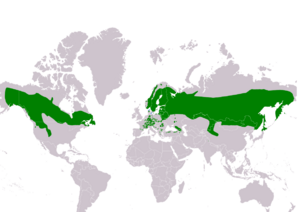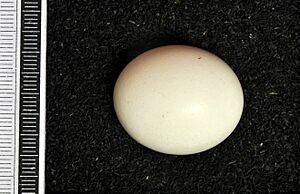Boreal owl facts for kids
Quick facts for kids Boreal owl |
|
|---|---|
 |
|
| Amherst Island, Ontario, Canada | |
| Conservation status | |
| Scientific classification | |
| Genus: |
Aegolius
|
| Species: |
funereus
|
| Subspecies | |
|
7, see text |
|
 |
|
| Range of A. funereus
Resident Non-breeding |
|
| Synonyms | |
|
|
The boreal owl (Aegolius funereus) is a small owl. It is also known as Tengmalm's owl in Europe. This name comes from a Swedish scientist named Peter Gustaf Tengmalm. In North America, it is sometimes called Richardson's owl.
These owls are very shy. They mostly hunt at night, which is called being nocturnal. They also live in thick taiga forests that are hard to reach. Because of this, people rarely see them in the wild.
Contents
About the Boreal Owl
How Scientists Name Them
The boreal owl was first officially described in 1758. This was done by a famous Swedish naturalist named Carl Linnaeus. He put it with other owls in a group called Strix. He gave it the scientific name Strix funerea.
Later, in 1829, a German naturalist named Johann Jakob Kaup created a new group. This group was called Aegolius. The boreal owl was then moved into this new group. The name Aegolius comes from a Latin word for a "screech owl." The word funereus means "funereal" in Latin.
Different Types of Boreal Owls
There are seven different types, or subspecies, of the boreal owl. They live in various parts of the world:
- A.f. richardsoni: Found in Alaska, northern Canada, and the northern United States.
- A.f funereus: This is the main type. It lives from Scandinavia south to the Pyrenees mountains. It also lives east to the Urals mountains.
- A.f. magnus: Found in northeast Siberia.
- A.f. sibiricus: Lives in southeast and south Siberia.
- A.f. pallens: Found in west and central Siberia.
- A.f. caucasicus: Lives in the Caucasus Mountains.
- A.f. beickianus: Found from northwest India to southwest China.
What Does a Boreal Owl Look Like?
The boreal owl is about 22 to 27 centimeters (9 to 11 inches) long. Its wings can spread out 50 to 62 centimeters (20 to 24 inches). Female owls are heavier than males. Females weigh about 131 to 179 grams (4.6 to 6.3 ounces). Males weigh around 107 grams (3.8 ounces).
Their feathers are brown on top. They have white spots on their shoulders. Their undersides are whitish with reddish-brown stripes. They have a large head with bright yellow eyes. Their face looks like a dull white circle. Some people say it makes the owl look "surprised."
Their beak is light yellow. This is different from their relative, the northern saw-whet owl, which has a dark beak. Boreal owls have ears that are not the same size. This helps them hunt better. Young owls have chocolate brown feathers. When they fly, they are very quiet and fly in a straight line.
Where Do Boreal Owls Live?
Boreal owls live in thick conifer forests. These forests are found across northern North America and a large area called the Palearctic. They also live in mountain ranges like the Alps and the Rockies.
These owls usually do not migrate (move to different places). However, in some autumns, many of them will fly further south. They usually do not go very far from their breeding areas. It can be hard to find them outside of breeding season because they are nocturnal and quiet.
How Boreal Owls Live Their Lives
Raising Their Young
Boreal owls start having babies when they are one year old. They usually make their nests in holes in trees. These holes are often made by woodpeckers. The owls also like to use special nest-boxes that people put out for them.
A female owl usually lays 3 to 7 eggs. She lays one egg every two days. The eggs are shiny white. They are about 33 by 26 millimeters (1.3 by 1.0 inches) in size. Each egg weighs around 12.5 grams (0.44 ounces).
Only the female owl sits on the eggs to keep them warm. She starts after the second egg is laid. The eggs hatch at different times, about 25 to 32 days later. The mother owl takes care of the baby owls. She keeps them warm for about 21 days. The young owls leave the nest when they are about 28 to 33 days old. They become fully independent when they are 5 to 6 weeks old.
What Do Boreal Owls Eat?
These small owls mainly eat small mammals. Their favorite foods are voles. They also eat mice, chipmunks, other squirrels, gophers, moles, shrews, and bats. They also hunt birds. Sometimes, they eat small amphibians, insects like beetles, and other tiny creatures.
In North America, they have been seen eating southern red-backed voles and western heather voles. They also eat jumping mice, northern pocket gophers, and northern flying squirrels. Birds they hunt include dark-eyed juncos, American robins, and common redpolls. Boreal owls mostly hunt at night. But in the far northern areas, they have to hunt during the day. This is because summer nights are very short there.
How Long Do They Live?
Boreal owls that have been tagged (with bands) have lived up to 16 years. However, because they are small, other larger owls and big birds of prey often hunt them. This means their average lifespan is usually shorter.




